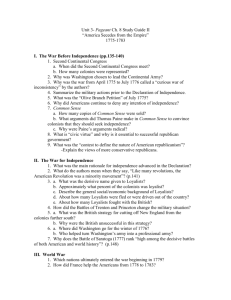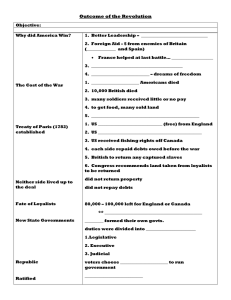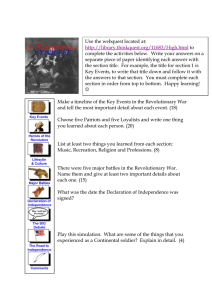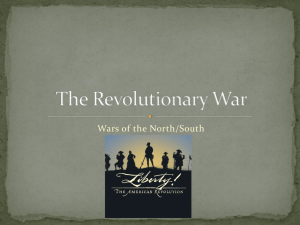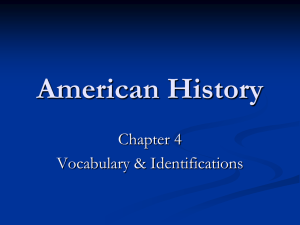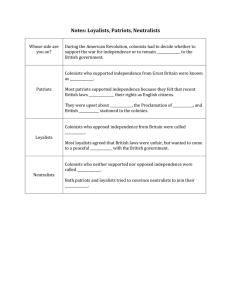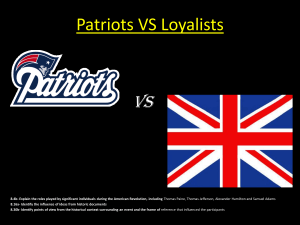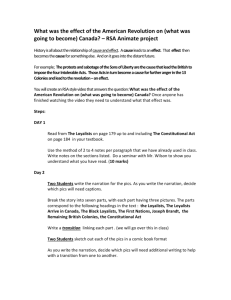Loyalists in the Bahamas: History Notes
advertisement
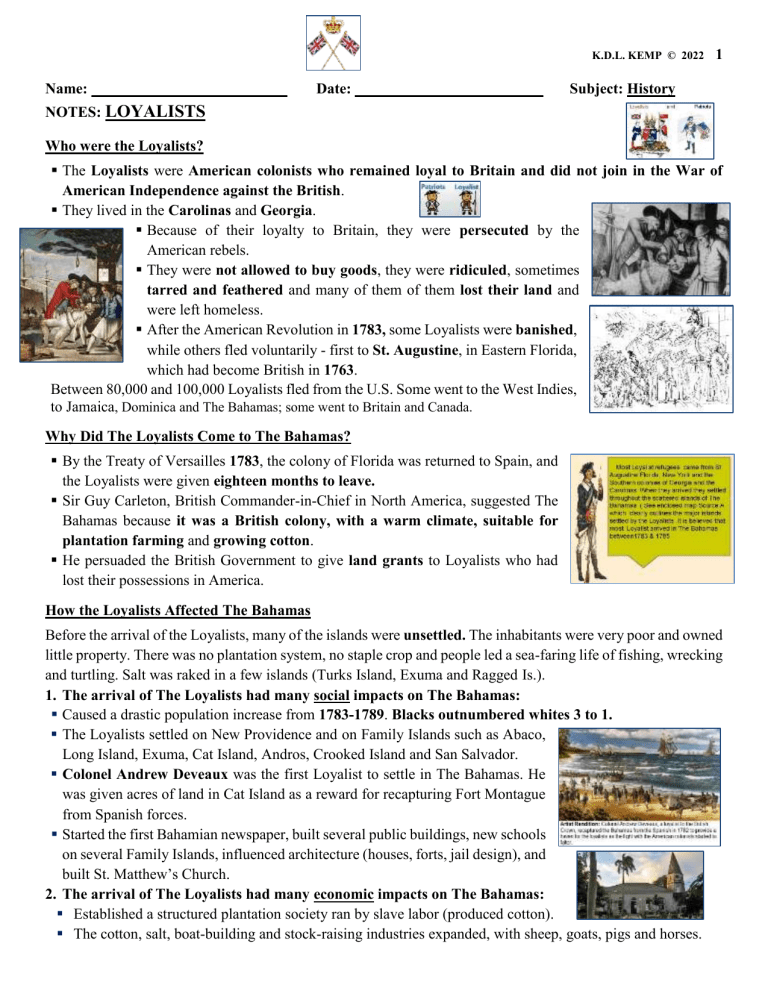
K.D.L. KEMP © 2022 Name: __________________________ Date: _________________________ 1 Subject: History NOTES: LOYALISTS Who were the Loyalists? The Loyalists were American colonists who remained loyal to Britain and did not join in the War of American Independence against the British. They lived in the Carolinas and Georgia. Because of their loyalty to Britain, they were persecuted by the American rebels. They were not allowed to buy goods, they were ridiculed, sometimes tarred and feathered and many of them of them lost their land and were left homeless. After the American Revolution in 1783, some Loyalists were banished, while others fled voluntarily - first to St. Augustine, in Eastern Florida, which had become British in 1763. Between 80,000 and 100,000 Loyalists fled from the U.S. Some went to the West Indies, to Jamaica, Dominica and The Bahamas; some went to Britain and Canada. Why Did The Loyalists Come to The Bahamas? By the Treaty of Versailles 1783, the colony of Florida was returned to Spain, and the Loyalists were given eighteen months to leave. Sir Guy Carleton, British Commander-in-Chief in North America, suggested The Bahamas because it was a British colony, with a warm climate, suitable for plantation farming and growing cotton. He persuaded the British Government to give land grants to Loyalists who had lost their possessions in America. How the Loyalists Affected The Bahamas Before the arrival of the Loyalists, many of the islands were unsettled. The inhabitants were very poor and owned little property. There was no plantation system, no staple crop and people led a sea-faring life of fishing, wrecking and turtling. Salt was raked in a few islands (Turks Island, Exuma and Ragged Is.). 1. The arrival of The Loyalists had many social impacts on The Bahamas: Caused a drastic population increase from 1783-1789. Blacks outnumbered whites 3 to 1. The Loyalists settled on New Providence and on Family Islands such as Abaco, Long Island, Exuma, Cat Island, Andros, Crooked Island and San Salvador. Colonel Andrew Deveaux was the first Loyalist to settle in The Bahamas. He was given acres of land in Cat Island as a reward for recapturing Fort Montague from Spanish forces. Started the first Bahamian newspaper, built several public buildings, new schools on several Family Islands, influenced architecture (houses, forts, jail design), and built St. Matthew’s Church. 2. The arrival of The Loyalists had many economic impacts on The Bahamas: Established a structured plantation society ran by slave labor (produced cotton). The cotton, salt, boat-building and stock-raising industries expanded, with sheep, goats, pigs and horses. K.D.L. KEMP © 2022 2 3. The arrival of The Loyalists had many political impacts on The Bahamas: The five new members were elected from the Family Islands to sit in the Assembly (for Exuma, Long Island, Cat Island, Abaco and Andros) were Loyalists. The Loyalists owned a lot of property and therefore had a lot of voting power and political influence. The Loyalists had many conflicts with the native Bahamians. Natives resented them because they were given free land grants and did not have to pay taxes on their land. Also, natives thought that Loyalists were taking over the political scene and gaining too much power. ECONOMIC EFFECTS Two main classes of Loyalists came: 1) Farmers who settled on the Out Islands. 2) Officers, merchants and professionals who settled mainly in New Providence and the Northern Bahamas. The influx of Loyalists and their slaves to The Bahamas caused a drastic population increase from 1783-1789. The Loyalists brought a number of Negroes both slave and free and the population trebled in 6 years. Some 1600 whites and 5700 slaves and blacks migrated permanently to The Bahamas. The population grew from 4,000 in 1783 to 11,300 in 1789. Blacks outnumbered the whites 3 to 1. The Loyalists settled mainly in the Family Islands such as Abaco, Long Island, Exuma, Cat Island, Andros, Crooked Island and San Salvador. Cotton plantations were established on these islands and soon it was a profitable industry which brought a lot of revenue to the islands. Because the soil had not been used extensively before, the Loyalists were able to keep very large crops of cotton. Why cotton expanded? 1) The land grant system initiated in 1785. Inhabitants were allowed to obtain claims to unoccupied areas of land in the Family Islands and also in Nassau. Each head of household was entitled to 40 acres, with an additional 20 acres for each dependent, white or slave, subject only to an annual quit rent of 2 shillings, per hundred acres. 2) The cotton gin was introduced by Joseph Eve in 1793. It multiplied the amount of cotton wool which one slave could process in a given time (up to 360 pounds in a day). At its peak, Bahamian cotton involved 3,000 working slaves, producing 600 tons a year from 12,000 acres of land. 3) Cotton production: 1785, 124 tons from 2,476 acres; In1787, 219 tons; 1790, 442 tons from about 12,000 acres. In 1788, 112 tons. There was peak in 1810, 602 tons. The cotton boom soon came to an end. By 1810 there were no pure cotton plantations left. Cotton was a marginal product, employing a smaller number of slaves for fewer days in the year. K.D.L. KEMP © 2022 3 Reasons for the Decline of Cotton 1. The Chenille bug, (a cotton eating worm that looks like a caterpillar), began to attack the cotton balls in 1788. By 1803, it had destroyed 3/4 of the cotton crop. 2. Another pest, known simply as the red bug began to stain the colour of the fibre. 3. The soil was thin and soon became infertile due to the poor cultivation methods. The inexperienced planters cleared the land without leaving any vegetation, which caused soil dehydration, erosion, and left cotton shrubs susceptible to cold winds. (slash and burn method). 4. Cold winds and drought added to the damage. 5. Other factors included: bad management practices, drought, hurricanes (1794, 1975, and 1798). By the early 1800s cotton had ceased to be a source of wealth for these inhabitants, many of whom returned to North America. When cotton failed, planters resorted to old subsistence crops such as guinea corn and yams. Many turned to salt raking, stock-raising and wrecking. Loyalists also started the boat industry in Abaco, the island where the greatest number of Loyalists lived. Salt Production Salt no doubt played an important part in the economy of The Bahamas. From 1789 salt-raking was regulated by law and salt commissioners were appointed by the Governor to serve each island or group of islands where there were salt ponds. The Bahamas was endowed with natural salt ponds or shallow lagoons where sea water evaporated rapidly and formed chunks of crystals. Salt had been exported from The Bahamas from the beginning of the 18th century. Turks Island, which was incorporated into The Bahamas in 1799 was especially renowned for salt. The Loyalists raked salt in Exuma, Long Island, Acklins and Long Cay. The most productive salt pond at that time was Duncan’s Town, Ragged Island. The pond was built by two Loyalists, Duncan and Archibald Taylor. Slaves employed in salt production had the hardest tasks and suffered more illness than other slaves. Slaves had to wait for the hot weather to crystallize the salt in the Salinas (ponds). The solid crystals then had to be broken and raked ashore. To facilitate the process, salt pans were made. As the salt was taken out, it was replenished with brine from the pond. Once it was raked into piles, it had to be packed and transported to a port with only animal and human transportation. Conditions were harsh as the bright sunlight, reflecting against the white salt affected the eyes. The slaves’ skin would get blisters, be raw, and peel from standing in brine all day. Salt Processing in the Nineteenth Century 1. Grant of salt ponds. 2. Salt ponds divided into shares. 3. Shares divided into pans (shallow flats of ½ acre each). 4. Salt water irrigation of Pans (by canal/hand) 5. Evaporation by the sun. 6. Deposits of saline crystals 7. Raking of salt into brownish heaps 8. Drying and bleaching by the sun. 9. Stored into thatched roof houses 10. Shoveled into bags and/or baskets 11. Transported to the sea by canal or railway 12. Loaded on tankers for export. K.D.L. KEMP © 2022 4 Stock Raising With the decline of cotton, stock-raising was also attempted by the Loyalists. By 1832 stock-raising was indeed important in nearly all the islands, especially New Providence, Rum Cay, Long Island, Watlings Island, Exuma and Cat Island. Sheep and goats thrived better than cattle, since they could survive on scrub pasturage with little water. West Indian sheep did well at Exuma. Long Island was the largest producer of stock. More horses and cattle were produced on Long Island than on any other island. It also produced the largest amount of sheep, goats and swine (pigs). Cat Island produced the second largest amount of sheep and goats and the second largest amount of cattle. New Providence produced the second largest number of horses next to Long Island. Social Changes The Loyalists were believed to be responsible for the widening of the colour line between blacks and whites. Previously, most of the old inhabitants lived with their slaves, mainly domestic servants. However, when the plantation system was introduced, master and slave were separated, with slave quarters being erected some distance from the main house. In 1784 the first Bahamian newspaper, The Bahamian Gazette was published by a Loyalist, John Wells. The Loyalists also built new schools. The School Act passed in 1795 provided for the creation of schools on Exuma and Long Island, and also for the establishment of a body of Commissioners to supervise all schools in the colony and examine prospective teachers. A few private schools were also introduced after 1783. Architecturally, the Loyalists made a great impact on the Bahama Islands. New houses designed on the southern architectural style were constructed. From 1787-1790 Lord Dunmore erected two forts, Charlotte and Fincastle. Dunmore also constructed the Hermitage and Dunmore House, which became the Governor’s mansion, from 1790-1815. Public Buildings were constructed along with the old jail which later became the Nassau Public Library. St. Matthew’s Church was built by Loyalist Joseph Eve from 1800-1802. In 1788 the First Post Office was established by Act of Parliament. The Loyalists were also responsible for the creation of the Chamber of Commerce and the Bahama Agricultural Society. Political Changes The Local inhabitants did not take too kindly to the new comers and as a result, conflicts between Loyalists and locals occurred frequently. There were conflicts in the House of Assembly over the presence of many Loyalists as members. During this time people who had property could vote. The Loyalists had lots of land, and hence more votes. Loyalists soon held the majority of seats in the Assembly, and could pass any laws they introduced. Five new members were elected from the Family Islands to sit in the Assembly. (For Exuma, Long Island, Cat Island, Abaco and Andros). References Saunders, G. (1983). Bahamian Loyalists and Their Slaves. London: McMillian Caribbean. K.D.L. KEMP © 2022 Name: _______________________________ Date: _________________________ 5 Grade: _____ Topic: The Loyalists Instructions: Answer ALL of the following questions in complete sentences. [25 marks] 1. Who were the Loyalists? [2 pts] ____________________________________________________________________________________ ____________________________________________________________________________________ 2. Why did the Loyalists come to the Bahamas? [3 pts] ____________________________________________________________________________________ ____________________________________________________________________________________ ____________________________________________________________________________________ 3. Name four Family Islands on which the Loyalists settled. [4 pts] ____________________________________________________________________________________ ____________________________________________________________________________________ 4. What factors caused the end of the cotton industry? [5 pts] ____________________________________________________________________________________ ____________________________________________________________________________________ ____________________________________________________________________________________ 5. Who did the Loyalists bring with them? [1 pt] ____________________________________________________________________________________ 6. Make a list of some of the public buildings built by the Loyalists. [3 pts] ____________________________________________________________________________________ ____________________________________________________________________________________ 7. What other industries did the Loyalists become involved in? [3 pts] ____________________________________________________________________________________ ____________________________________________________________________________________ ____________________________________________________________________________________ 8. What was one social impact that the Loyalists had on The Bahamas, after their arrival? [3 pts] ____________________________________________________________________________________ ____________________________________________________________________________________ ____________________________________________________________________________________ K.D.L. KEMP © 2022 6 The American War of Independence and the Loyalists Background The causes of this war are complex. By the 1770s many American colonists resented Britain’s interference in their internal affairs particularly because of excessive trade restrictions and taxation. The North American colonies preferred to buy sugar from the French colonies because their goods were cheaper than what the British West Indian colonies produced. To prevent this, Britain passed the Molasses Act 1733, which was renewed by the Sugar Act 1764, forbidding American trade with the French and Spanish islands. American colonists continued to trade with the French and Spanish colonies even when Britain was at war with Spain and France. At the end of the Seven Years’ War (1756-63) the British Government passed the Stamp Act 1765 to tax the American colonies in order to cover the expenses of the war which in part had been fought in their defence. This Act required a stamp on all legal documents, including newspapers. Since the French had been defeated in Canada, the American colonists did not think they needed British protection any longer. They objected to paying the tax on the grounds of “No taxation without representation.” The Stamp Act was repealed in 1766. When Britain imposed high customs duties on items such as glass, paper and tea, making these items more expensive, the colonists refused to buy them. The British Government gave the East Indian Company the sole right to sell tea to America without paying customs duties. American merchants saw themselves losing the valuable tea trade and they gave their support to the movement for independence. On the 16th December 1773, a band of American colonists disguised as Mohawk Indians went on board the East India Company’s ship and threw its cargo of 352 tea chests into the water. This was known as ‘The Boston Tea Party’. This incident led the British to close the port of Boston and place more restrictions on the people of Massachusetts. In April 1775 British and American troops clashed at Concord and Lexington in Massachusetts and the Americans officially declared war on Britain, July 4th 1776. In 1778 France joined the Americans against Britain. Spain and Holland joined in 1779. Effects of the War of American Independence 1. In 1776 Commodore Ezekiel Hopkins of the American navy attacked and took possession of Nassau. The Americans stayed for two weeks but they left when they found no ammunition. It had been shipped out of the colony by Governor Browne. The Americans attacked again in 1778 staying two days. 2. May 1782, a combined Spanish-American fleet attacked Nassau and for one year the Spaniards occupied the islands. The Bahamas was returned to Britain by the Treaty of Versailles in September 1783. Colonel Andrew Deveaux recaptured Nassau from the Spanish garrison. 3. Another effect of the war on the Bahamas was that many of the citizens were reduced to starvation because no supplies could be imported from America. 4. The coming of the Loyalists to the Bahamas was the most important effect of the war.
